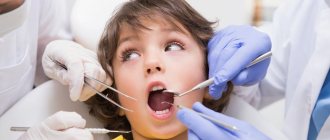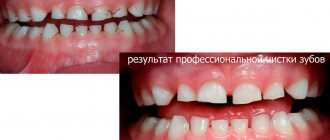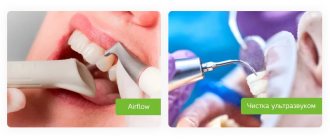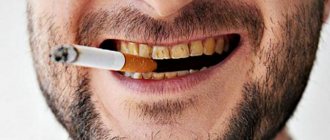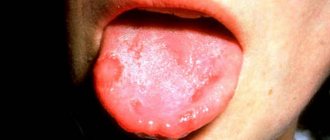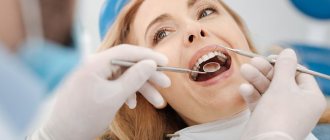Black plaque on teeth, or Priestley's plaque, occurs for various reasons. It may indicate caries, gastrointestinal problems, enamel diseases, or simply poor oral hygiene. It often appears in children aged 2-3 years. In this article we will tell you what to do if your child’s teeth become black.
In this article
- Black plaque on children's teeth: causes of formation
- A child has black teeth - what to do?
- Black teeth in children: possible complications
- Other types of plaque depending on color
- Prevention of dental plaque in children
Black plaque on teeth can appear suddenly at any age, but, according to statistics, it is 8-10 times more common in children. It looks like an uneven border of a dark color, almost black, running along all the teeth closer to the gums. In rare cases, it appears as a small spot or blackhead, often forming on the inside of the teeth.
This symptom is also called Priestley's plaque in honor of the scientist who first described it. He also named the possible reasons for its formation. The danger to health is not so much the plaque itself, which is not a pathology, but a symptom, but rather the disease that provoked its appearance.
What is Priestley's plaque
Plaque on baby teeth of a yellowish, black or brown color appears in a child when bacteria actively multiply in the oral cavity. Priestley's plaque is often seen at an early age, but can also occur in older children. When deposits appear, teeth lose their attractiveness, which can negatively affect the child’s psychological state. If symptoms of this unpleasant phenomenon develop, you should immediately contact your dentist to eliminate Priestley’s plaque in children.
A child has black teeth - what to do?
It is dangerous to ignore this symptom, since the pathology that caused it will develop further. In addition, plaque is a favorable environment for the active proliferation of bacteria, therefore increasing the risk of developing caries.
Diagnostics can take place in several stages. First, the dentist will examine the child's teeth for caries. If caries is excluded, examination using laser equipment and radiography are prescribed. You may need to consult with doctors of other specialties. In cases where no pathology is detected, plaque is simply removed during an ultrasound procedure.
Treatment depends on the cause of the black plaque. If a child is diagnosed with intestinal problems, he is prescribed medications that restore the balance of microflora and his diet is adjusted. If there is a lack of calcium and iron in the body, an appropriate diet is prescribed, including foods containing essential microelements. If caries develops, remineralization or filling is performed. It all depends on the stage of the carious lesion.
Causes of black plaque in children
The main causes of black plaque on teeth are:
- Priestley plaque is the main cause of deposits. Growing up, the child gets rid of this problem, since plaque almost never settles on permanent teeth. This phenomenon does not harm health and is characterized as a purely aesthetic defect.
- Tooth decay is a serious disease that can lead to tooth loss. The carious process is accompanied by yellowing and subsequently blackening of the tooth enamel. When the first symptoms appear, you should immediately consult a dentist.
- Dysbacteriosis is a disease that leads to the appearance of dental plaque due to disturbances in the functioning of the digestive system. The causes of the disease are poor diet, long-term use of medications, chronic diseases affecting the liver or intestines.
- Oversaturation of the body with iron. Prescribing iron-containing medications to children leads to the formation of both black plaque and deposits that are dark purple or brown in color.
In addition, teeth can darken due to a lack of calcium in the body caused by some disease. In general, the exact cause will be revealed during an examination by a dentist.
Other types of plaque depending on color
In addition to black, white or brown plaque may form on a child’s teeth. Green and orange deposits on tooth enamel are also possible. Normally, plaque appears on the teeth of all people; it usually has a light yellow tint. You need to keep this under control, brush your teeth regularly and periodically undergo ultrasonic cleaning - 1-2 times a year. If the plaque takes on any color, you should definitely see a dentist.
White plaque forms on the teeth after every meal. At night, if the oral cavity is not cleaned before bedtime, it continues to grow. Over time, it can harden and turn into tartar, which is a favorable environment for the proliferation of cariogenic microorganisms.
Brown plaque is caused by poor hygiene, overuse of coffee and tea, and smoking. Removing such pigmented plaque at home is problematic. You can use special toothpastes with abrasives, but they have contraindications. To completely get rid of brown plaque, you will have to visit the dentist's office and undergo professional teeth cleaning.
Orange or greenish deposits on the enamel indicate the growth of fungi in the oral cavity. Plaque forms not only on the teeth, but also on the inner surface of the cheeks, gums and tongue. Remove deposits in the dentist's office. Immunoenhancing therapy may also be required to eliminate the fungal infection.
What does ignoring the problem lead to?
Failure to promptly contact a dentist when plaque appears on baby teeth leads to the following negative consequences:
- development of the inflammatory process;
- bleeding gums, which occurs if the child eats or brushes his teeth;
- the likelihood of developing diseases such as caries, stomatitis and periodontal disease increases;
- milk teeth with a black coating are very unaesthetic, which is fraught with the development of complexes in the child;
- deposits may be accompanied by bad breath.
Removal techniques
So, you have found black plaque on your teeth, what should you do? The first step is to make an appointment with a dentist. Depending on the degree of damage and medical history, the doctor will select a treatment method.
The fundamental factor in choosing therapy is the causes of dark plaque on the teeth, so tests and diagnostics may be required. In some cases, consultation with a specialist may be required (in the presence of chronic diseases).
Ultrasound is recognized as an effective, proven and safe way to remove black plaque on teeth. For the procedure, a special device is used - a scaler. It emits ultrasonic vibrations and transmits them through the tip to the tooth surface. Under the influence of ultrasonic vibration, deposits are destroyed and separated from the enamel.
Ultrasonic cleaning is painless, does not cause health problems, teeth do not hurt after it and you can lead a normal lifestyle. It can be carried out for both adults and children.
A reliable result is demonstrated by the procedure using Air Flow technology. It will return your teeth to their original appearance, eliminate blackening and deposits, and restore the beauty of your smile. Can be used both in the lateral and frontal zones.
This method uses the sandblasting principle of processing sand of a certain dispersion. A mixture of water, air and abrasive particles is applied to the tooth surface under high pressure. The enamel is polished, becomes smooth and is cleared of pigment and solid particles.
These were the basic tips on how to remove black plaque on teeth, but it is wiser to still use preventive measures and not lead to clinical treatment.
Preventing the reappearance of black plaque on teeth
Prevention of plaque formation includes:
- Regular dental and oral care. For babies, their gums are cleaned using cotton pads and special silicone tips. When the baby turns two years old, he needs to be taught to properly brush his teeth with a brush and toothpaste, as well as to regularly rinse after meals.
- Balanced diet. Your child's diet should include fewer sugar-laden foods and more natural fruits and a variety of vegetables.
- Timely limitation of the use of pacifiers and bottles. Long-term use of these items leads to the appearance of malocclusion, the development of a certain dependence, and the formation of so-called “bottle caries.” If a child can do without a pacifier and bottle, they should be disposed of.
In addition, you should constantly monitor the state of the child’s immune system and support it with the help of vitamins, which have a beneficial effect on the health of the teeth and the whole body. If you follow these simple recommendations, your child will always delight his parents with his beautiful and healthy smile.
How to remove black plaque
Daily hygiene and thorough rinsing cannot remove insoluble stains from the enamel surface. But they must be removed: this is harmful to the gums and threatens their inflammation; there may be a cavity under them and this is not aesthetically pleasing.
To restore the whiteness and health of teeth, professional cleaning by a pediatric dentist is necessary using delicate methods and tools that will not damage children’s delicate enamel, as well as:
- Polishing using microabrasive pastes.
- Remineralization with compounds containing high fluoride content.
Causes of yellow teeth
Most often, children's teeth turn yellow due to parental neglect. They must understand that they need to take care of their oral cavity from the moment the first tooth emerges. In advanced conditions, plaque removal will be required. The causes of yellowness may be hidden in acquired diseases. The color of children's crowns is negatively affected by jaundice, as brown spots appear. Also, a dark shade may appear due to problematic digestion.
As a result of mechanical damage, the enamel may crack or chip. And, as a result, yellow spots appear. The pathology is caused by hypoplasia of the enamel layer, under which there is yellowish dentin. In this case, the teeth are already yellow at the time of eruption. Factors in the development of hypoplasia include pathologies of the mother during pregnancy. After all, organs are laid down and mineralized in the womb. Precipitating factors include maternal infections and toxicosis, birth trauma, and prematurity of the infant.
Rare diseases can also be to blame for yellowness. We are talking about dentinogenesis imperfecta and amelogenesis. The first pathology develops with a congenital disorder of the dentin development process. And the second disease is associated with improper formation of the enamel layer. Most often, such anomalies are characteristic of girls. Their treatment is complex and must be started immediately after the units appear.
Eating junk food
Often, yellow teeth in a child are the result of food dyes. This situation is caused by frequent consumption of pumpkin and carrot juice. Orange dyes penetrate microcracks very easily, causing the crown to turn yellowish. Coloring vegetables, berries and fruits, for example, beets or blueberries, also work. Their bright color stays on little teeth!
It is necessary to remember the negative impact on acid units. It could be a too sour apple or applesauce, orange or lemon juice. They can cause acid necrosis. The cracks that appear are immediately filled with dyes and the crowns become dark. It should be noted that iron also affects the shade of enamel. Most often, this situation is typical for well water in rural areas where there are no filters.
A separate conversation about sweets, baked goods, candies, chewing gum with sugar. Particles of these products that remain in the mouth provide a favorable environment for bacteria and pathogenic microorganisms that settle in plaque. Here it is appropriate to remember that the most harmful food is its increased dose!
Poor oral hygiene
Children who do not know how to brush their teeth are most at risk of developing unsightly stains. Therefore, it is important to teach your child how to properly use a brush and toothpaste. It is good if parents keep this process under control. Well, when the situation is difficult, you need to have your teeth cleaned of yellow plaque by a professional hygienist. Only daily procedures at home will consolidate the results and prolong the effect.
- The first incisors are wiped with a soft bristle brush after any feeding.
- When the baby learns to hold the hygiene instrument himself, he needs to be taught the rules of brushing his teeth.
- The brush and paste are selected according to age. The dentist will provide invaluable assistance with this.
- Parents should monitor the cleaning process until 8-10 years of age.
- Children with orthodontic elements are subject to special monitoring. Monthly professional cleaning is the norm for these guys.
With improper care, unsightly plaque, stones and plaques appear. This worsens the child’s appearance and increases the risk of developing dental diseases. We are talking about caries, gingivitis, periodontal disease, and pathologies of the ENT organs.
Taking medications
Some medications cause enamel discoloration. This group of antibiotics primarily includes tetracycline and amoxicillin. If taken by a pregnant woman, it usually causes her baby's teeth to turn yellow. Often these drugs are prescribed to children themselves, even up to one year old. Their frequent use almost always contributes to darkening of the enamel. What to do? In such a situation, hygienic cleaning of the oral cavity is indicated. Professional dentistry will correct the unsightly condition. “Tetracycline teeth” can be whitened using modern technologies. Of course, such procedures should be prescribed to the child by a doctor.
Genetic predisposition
It has long been proven that the color of units is strongly influenced by genetics. If parents have dull teeth, then it is not surprising that the same yellow spots will appear on the child’s teeth. True, the factor of heredity does not occur often, so it cannot be called determining. But you shouldn’t write off genetics either. Today, more and more medical scientists are proving its importance. When diagnosing and developing a treatment program, the dentist must take into account the genetic line so that the therapy is effective.
Poor maternal nutrition during pregnancy
During the period of bearing a child, a woman must eat properly and nutritiously in order to receive valuable microelements and vitamins from food. If the diet is unbalanced, the fetus does not develop fully. From birth, such babies have thinned enamel due to the fact that even in the womb there was a deficiency of nutrients, especially calcium, vitamin and fluoride. Brown dentin will be visible through the thin layer. This causes yellow plaque on the child’s teeth. Therefore, a prerequisite for the proper development of the fetus is the rational nutrition of its mother.
To prevent the child’s teeth from deteriorating, the mother must have enough calcium and fluoride. A powerful source of calcium is sesame. The seed must be thoroughly crushed or chewed to release the beneficial trace element. Don't forget about bananas, salmon, broccoli and olive oil. To replenish fluoride reserves, you need to include avocados, carrots, cucumbers, and dates in your diet.
Why do teeth darken?
When a child develops dark plaque, this indicates the proliferation of pathogenic microbes that are deposited on the tooth enamel.
Black deposits may be a sign of:
- thyroid diseases;
- diabetes mellitus;
- helminthiasis;
- dysbacteriosis;
- immunity disorders.
Dark plaque on a child’s tooth enamel appears due to dental pathologies:
- tartar;
- caries;
- mineral deficiency;
- enamel hypoplasia;
- malocclusion.
The cause of tooth discoloration may be the effect of dyes, a disorder in the intrauterine development of the child, or a genetic predisposition.
Enamel hypoplasia
We are talking about severe thinning, partial or complete absence of enamel. Hypoplasia is a disease that manifests itself not only in the form of whitish spots, but also grooves and depressions on the tooth surface. It can be triggered by various factors:
- infectious diseases during pregnancy;
- Rh conflict between mother and fetus;
- premature birth;
- birth injury;
- taking certain illicit drugs by a pregnant woman;
- disturbances in the functioning of the endocrine, nervous systems or gastrointestinal tract.
The pathology is accompanied by increased sensitivity of teeth to irritants and caries.
Prevention
All pathologies require preventive manipulations that are aimed directly at removing plaque and strengthening the affected tooth enamel.
Preventive procedures.
- Professional teeth cleaning.
- Remineralization of enamel.
- Fluoridation of teeth.
The dentist consults with parents and the child to teach proper oral hygiene. The specialist also gives recommendations on the choice of dental care products. For general strengthening of the body and dental tissues in particular, a vitamin-mineral complex is prescribed.
White spots on enamel: what are they?
More often, white spots appear on baby teeth, less often on permanent teeth. Experts divide them into two classes:
- carious - those that are associated with the development of caries;
- non-carious.
White areas on the enamel indicate its demineralization. A whitish line may also appear at the edge of the gums of the front teeth. In any case, consultation with a doctor is required.
Compared to permanent teeth, baby teeth are more susceptible to caries. Their enamel is thin and porous, which allows bacteria to easily penetrate inside. The disease progresses quickly, so in a short period of time there may be nothing left of the tooth. There is a risk of damage to the “successor” rudiments. These facts refute the opinion of some parents that there is no need to treat baby teeth, since they must be replaced.
Prevention of Priestley's plaque
Unfortunately, despite cleaning, this pigmentation may appear again: even professional hygiene does not eliminate the causes of Priestley's plaque. You will have to regularly examine your child’s teeth and have them brushed by the doctor as many times as necessary.
Priestley's pigmentation rate can be slowed down.
For prevention, experts recommend:
- Taking probiotics to control the number of chromatogenic bacteria and iron levels in saliva.
- Eat a proper diet. Avoid excess iron-rich foods in your children's menu. Give preference to dairy products: this increases the number of beneficial bacteria in the mouth and helps maintain a healthy and balanced microflora.
- Remind your child to brush their teeth at least twice a day and use mouthwash. This will help remove the bacteria responsible for Priestley's plaque buildup.
- After each cleaning, rinse your child’s brush well and pour boiling water over it so as not to create an environment favorable for the growth of bacteria.
If you notice black plaque on your child’s teeth, make an appointment at the Smileyk clinic by phone. The pediatric dentist will diagnose the type, help you get rid of it, and check for caries underneath the dark spots.
Treatment at the dentist's office
A modern dental clinic offers a wide range of services, including procedures for cleaning teeth from black plaque and their subsequent strengthening. Treatment for dental diseases directly depends on the pathology that provoked the appearance of dark deposits.
Caries treatment is carried out using classical or innovative techniques. All manipulations are performed using anesthesia and do not cause pain to the child.
Diseases such as enamel hypoplasia, tartar and mineral deficiency require mainly preventive procedures, which include oral hygiene and strengthening teeth.
Malocclusion leads to damage to teeth, wear and thinning of enamel and discoloration of teeth. Treatment of bite pathologies involves wearing special orthodontic structures.
How can you not be afraid of the dentist from childhood?
Dial-Dent hygienists have extensive experience working with children. At the appointment, hygienists talk about how to properly brush your teeth so that caries is not a problem, and how and why the doctor treats your teeth.
A friendly atmosphere at the reception, children's songs during the procedure, gifts after visiting the doctor - all this builds a positive image of the dentist in the child. That is why, having visited the clinic several times, a six-year-old girl quite calmly goes to see a doctor she knows, knowing that there is absolutely nothing to be afraid of. This is very important because children who do not have fear of the dentist grow into adults who are not afraid to get their teeth treated on time and do not panic at the mere sight of a dental office. Unfortunately, the Dial-Dent clinic is often visited by adult patients who were so frightened by dental treatment in childhood that they can now treat their teeth only under anesthesia.
The cost of professional dental hygiene for a child is 2,740 rubles (professional teeth cleaning for children is 2,090 rubles, strengthening enamel with Tuss Mousse cream is 650 rubles).
See other works of Dial-Dent specialists here.
Prevention is better than cure
Parents should think about healthy teeth and a snow-white smile for their children from a very early age:
- Start care when the first baby tooth appears. Using dental wipes, a silicone fingertip with a brush, you should brush your baby’s teeth and massage the gums.
- Teach children from the age of 2 to use a brush correctly and brush their teeth twice a day, rinse their mouth after eating.
- Starting from the age of one, you should visit pediatric dentistry with your child twice a year.
- Provide a balanced diet with sufficient vitamins and minerals.
- Wean your child off pacifiers and bottles in a timely manner to form a correct bite.
- Introduce solid foods into your diet to naturally cleanse tooth enamel.
- It is imperative to treat caries of baby teeth.
Such preventive measures and compliance with the rules of oral hygiene will help avoid the appearance of black teeth in a child.
